As you may remember, Essential Report runs a semi-regular set of questions that measure public perceptions on various attributes of political leaders – from positive attributes like Trust and Visionary through to negative attributes like Arrogant and Superficial. Over the last two and a half years, the following question has been asked 6 times about the Coalition leader and 5 times about the Prime Minister:
Which of the following describe your opinion of [insert leader]?
They then give the following list of attributes: Intelligent, Hard-working, A capable leader, Demanding, Arrogant,Out of touch with ordinary people, Understands the problems facing Australia, Visionary, Superficial, Good in a crisis, Narrow-minded, Down to earth, Too inflexible, Complacent, More honest than most politicians and recently Essential have added Trustworthy as an attribute as well.
As a result of the regularity of these polls, we can take a longer look at the issues involved and track how the attributes of the leaders have changed on an approximate yearly basis since there were polls taken in June/July 2008, June 2009 and May 2010.
If we run the figures for the PM, the Opposition Leader and the difference between the two – as well as group each into positive and negative attribute scores, this is what we get (click to expand)
I’ve also added our phone pollster trend value of the two party preferred to those tables as well, to give us some context in terms of how the vote was playing out at the time those polls were taken.
What is interesting here – apart from the general longer term changes in various attribute ratings, is the way the average positive and negative attribute scores (the simple average of the positive attributes and the simple average of the negative attributes) interact with the vote estimates. We have 11 observations of positive and negative attribute averages available from the 6 Coalition and 5 ALP polls where attributes have been measured – if we chart them against the two party preferred vote estimate at the time (using the phone poll trend), this is what we get (click to expand):
On the positive attributes side of things, as the average positive attribute score increases for both government and opposition leaders, so too does the two party vote in the polling. The relationship is fairly strong and tightly linear and suggests that the more positive is the general vibe of a leader, the better they can expect to perform in terms of the party vote.
With the negative attributes, while there is still a relationship between the vote estimates and negative attributes scores (in the opposite direction), there’s much more variation involved. However, the dynamics become much more interesting if we run the same charts again, but this time split the results by party (red for the ALP, blue for the Coalition)
While the relationship between general positivity of attribute ratings and the two party vote holds across both government and opposition (albeit slightly less with the opposition), on the negative attribute ratings, it is really only the government side of politics where negativity plays ball with the vote estimates.
This suggests that for governments (or at least this government), perceptions of Rudd’s personal attributes are tied up with the size of the vote the ALP is getting at any time. Whether it is the public perception of Rudd that drives political support or whether it is changes in generic political support that drive public perceptions of Rudd isnt clear (causality direction – please discuss! 😛 ) – but the relationship over the last two years is pretty solid.
With the Opposition however, the level of general negativity the public displays towards the Opposition leader hasn’t changed as the vote they are receiving in the polling has changed. Only on the positive side of the coin is there a relationship between attribute ratings and the vote estimates – although one much weaker than the government is experiencing.
Ultimately, this suggests that what the public believes about Rudd is much more important in terms of delivering votes to the ALP over the spectrum of 50-56 % of TPP than what the public believe about the Opposition leader. It also suggests that while Oppositions can get away with running purely negative campaigns and have a fair level of success with them, governments can not – they also need to deal with the positive side of their leaders public perception ledger.
UPDATE:
Apparently the comments were off here too like last post. Apols, they’re on again.
When default settings go bad (insert ominous music).

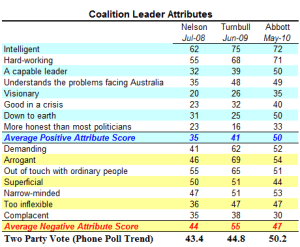
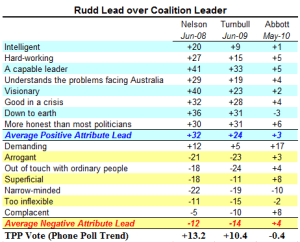
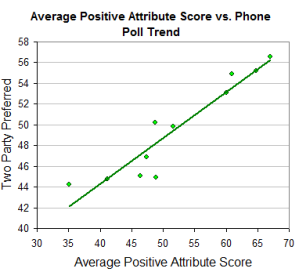
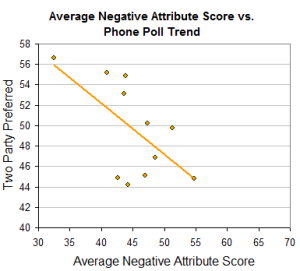
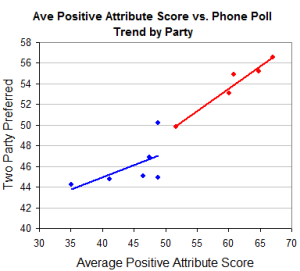
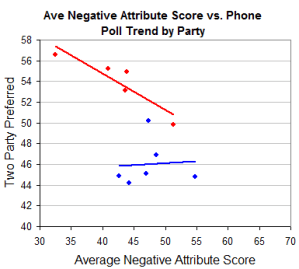






Crikey is committed to hosting lively discussions. Help us keep the conversation useful, interesting and welcoming. We aim to publish comments quickly in the interest of promoting robust conversation, but we’re a small team and we deploy filters to protect against legal risk. Occasionally your comment may be held up while we review, but we’re working as fast as we can to keep the conversation rolling.
The Crikey comment section is members-only content. Please subscribe to leave a comment.
The Crikey comment section is members-only content. Please login to leave a comment.